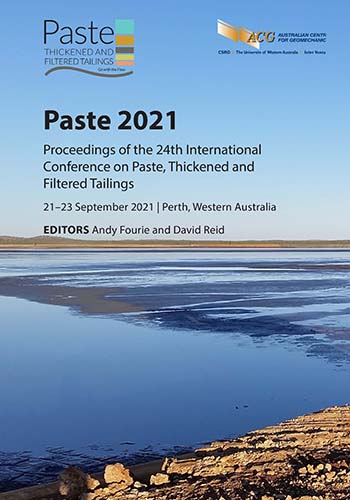A simple test to determine the settling behaviour of slurries in piston diaphragm pumps

|
Authors: Krimpenfort, H; Nägel, D |
DOI https://doi.org/10.36487/ACG_repo/2115_21
Cite As:
Krimpenfort, H & Nägel, D 2021, 'A simple test to determine the settling behaviour of slurries in piston diaphragm pumps', in AB Fourie & D Reid (eds), Paste 2021: Proceedings of the 24th International Conference on Paste, Thickened and Filtered Tailings, Australian Centre for Geomechanics, Perth, pp. 253-262, https://doi.org/10.36487/ACG_repo/2115_21
Abstract:
One of the most critical issues when designing a slurry system is sedimentation of solid particles in pipelines and pumps. In pipelines, sedimentation will occur when the transportation velocity of a slurry through the pipe is below the deposition velocity. As soon as particles are settled, there is a considerable risk that, in time, a plug will be created which will block the pipeline completely. Settling of solids can, however, also be detrimental for piston diaphragm pumps; large and heavy solids may settle within the diaphragm housing, on top of the suction valves. This layer of solids will cause diaphragms to rupture. In addition, there is a risk that the settling particles may block the valve, causing pressure surges and further damage to the downstream equipment. In order to determine the settling behaviour of a slurry, costly and time-consuming loop tests need to be executed in specialised laboratories for which large quantities of solids are required. This test may also be an indication of the settling behaviour of solids within a piston diaphragm pump, but would not be very accurate, leaving risk of damage to diaphragms. Therefore, a simple, quick and inexpensive test (SE: sedimentation detection system with evaluation algorithm) was developed which indicates if a slurry is prone to settling or not, by determining how fast solids will settle within a diaphragm housing. For this test, just a few kilograms of solids are required, and the result of the test is known within a very short period of time. In principle, the test is based on the measurement of the speed at which particles settle on a scale; the faster the particles settle, the higher the risk of a settled pipeline and the higher the transportation velocity needs to be. This paper will describe the methodology of this test, its results and interpretation. Also, a technology will be presented which prevents settling of solids within the diaphragm housing of piston diaphragm pumps.
Keywords: pump systems, sedimentation, test, down-flow
© Copyright 2025, Australian Centre for Geomechanics (ACG), The University of Western Australia. All rights reserved.
View copyright/legal information
Please direct any queries or error reports to repository-acg@uwa.edu.au
View copyright/legal information
Please direct any queries or error reports to repository-acg@uwa.edu.au





